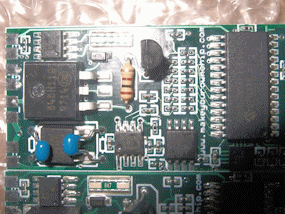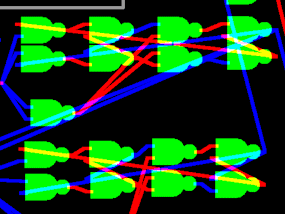Imagine the universe to be non continuous and the calculus to represent only an
approximation. Space and time are discrete units which have a lower limit in size and can assume only a finite set of properties and be arranged in a numerable set of possibilities. In this mindset the cosmos is a cellular automaton where the future is computable and the laws of physics are exactly determinable. Of course these ideas are controversial and there are discrepancies with many of the interpretations of quantum physics. Many experiments
seemingly clearly reveal the hidden variable theories to be inadequate explanations and belong in the realm of metaphysics – that which attempts to explain why physics is the way it is, w
hich may be an indeterminable. However, it is obvious by analogy that the universe very well could operate as a cellular automaton and whether or not this idea is provable, many interesting correlations can be extracted, including possible reasons why we may never know.
The Game of Life, a simple two dimensional cellular automaton which exhibits complex interactions and has been shown to be capable of universal computation has many similarities to our own world. Various types of machines can assembled within this cellular automaton, such as gliders, which are so common, they are naturally occurring within the system. Other machines

are sufficiently complicated that a natural origin for their existence could only be reasonably explained by evolution or, in the far more common case they are preprogrammed by the humans running the simulation, such as a complete universal computer. Since a computer is a machine
which can emulate any other algorithmic solving machine, it is as powerful as any other computer, at least in terms of computability. However probable or not, our universe may be being emulated through a computer built within a cellular automaton operating by The Game of Life rule set.
It is important to realize any implication for the specialness of the Game of Life is non existent and it was only used as an example. A cellular automaton of any number of dimensions, which is capable of performing universal computation, is capable of emulating another system which could be our universe. This means that physical laws around us are not necessarily meaningful in describing the true mechanism used to process this univer
se. In fact, the nested depth of emulation could be infinite, meaning essentially there could be no beginning to the process. This approach requires no confrontation to the question of what ultimately began existence, it would simply be the product of an infinitely long series of simulations. This doesn't mean we are not real. The term has little meaning at all, since reality seems to consist of information alone.
With sufficient computer power it would be possible in principle to simulate another universe, most likely smaller than our own but not necessarily, which could give rise to self aware lifeforms which may ponder over their own existence, completely oblivious that they are being watched on a computer screen. As in most cellular automata, the mechanisms, or laws of physics, may not allow information passing between the simulation and the simulator. Those within the simulation would have no knowledge of the higher realm and nothing they could ever do or build could allow them access unless a process for doing so was explicitly part of the rules.
Examples of naturally occurring cellular automata have been found on Earth in certain types of crystals, the color patterns of animals, and the finger prints on our hands.

Although we may be a simulation within yet another simulation, it is not necessary to assume that these simulations were designed with purpose by an intelligent entity, although either view is plausible. In my opinion the universe is probably naturally occurring, is part of an infinite chain of other simulations, and is a direct example of a specific cellular automata rather than a program being evaluated linearly on a universal computer. If this is the case, a systematic search for our universe's rule set could be done and once found, would be of great importance to our understanding of what is and is not physically possible. Keep in mind however, that the stability of the physics we see around us is not a guaranty. There is no way of knowing if rules can be modified, either globally or locally. The quest for understanding is an infinite journey, keep your mind open.
















